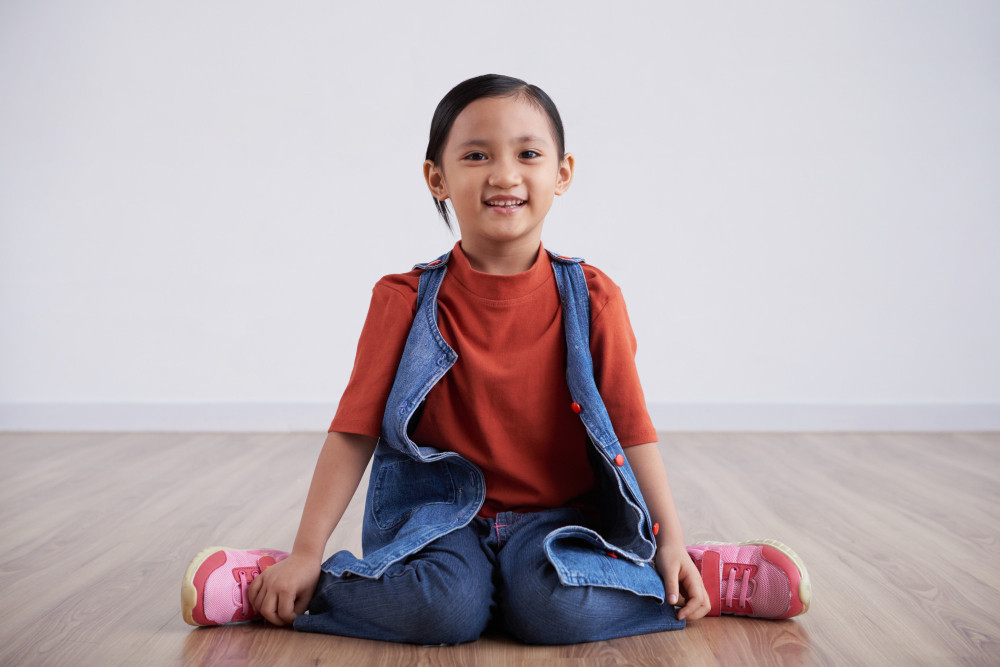Pernahkah Anda mengamati bagaimana posisi si kecil ketika duduk di lantai? Beberapa anak duduk dengan posisi lutut kaki membentuk W. Berbahayakah posisi duduk ini untuk anak-anak? Simak ulasannya berikut ini.
Penyebab Anak Suka Duduk dalam Posisi W
Duduk dalam posisi W merupakan salah satu posisi duduk yang banyak digemari anak-anak terutama usia balita. Posisi duduk W adalah posisi dimana lutut anak berada di depan tubuh sedangkan kedua kaki berada di samping masing-masing panggul. Disebut duduk posisi W karena jika dilihat dari atas posisi duduk ini mirip huruf W.
Posisi ini banyak digemari anak-anak karena bukan hanya dapat menopang tubuh dengan baik, tetapi juga memudahkan anak untuk bergerak memutar ke belakang atau samping untuk menggapai barang yang ada di sekitarnya. Dalam posisi ini, anak-anak tidak perlu terlalu banyak menggunakan otot inti untuk duduk tegak.
Baca Juga: Tips Mengatasi Anak di Atas Usia Balita yang Masih Mengompol
Berbahayakah Duduk dalam Posisi W?
Banyak orang tua khawatir melihat posisi anak terbiasa duduk dalam posisi W. Beberapa anak umumnya menyukai posisi ini ketika mereka berusia 2-5 tahun. Semakin dewasa, posisi duduk ini semakin sering ditinggalkan. Pada dasarnya posisi duduk ini tidak berbahaya dan aman bagi anak-anak.
Akan tetapi, jika si kecil hanya bisa duduk dalam posisi W saja, sebaiknya periksakan ke dokter. Orang tua juga harus waspada apabila anak yang sering duduk posisi W mengalami keterlambatan berjalan, atau anak dapat berjalan namun terdapat perubahan dari cara berjalan, atau anak berjalan dengan posisi berjinjit. Segera konsultasikan ke dokter jika anak mengalaminya.
Beberapa risiko yang dapat muncul akibat kebiasaan duduk dalam posisi W antara lain:
Kelemahan batang dan kaki
Duduk dalam posis W menjadi posisi duduk favorit si kecil karena kaki atau badannya tidak cukup kuat untuk menopang dan menjaga kestabilan saat bermain.
Saat duduk dengan posisi ini, kaki akan mengambil beban kerja otot dan menciptakan pusat gravitasi yang lebih rendah dengan alas yang lebih lebar untuk mendukung gerakannya. Akibatnya batang tubuh tidak terlalu banyak bergerak sehingga membuat anak menjadi lebih seimbang.
Jika si kecil sering duduk dalam posisi ini, Anda perlu waspada tanda-tanda kelemahan dan kekuatan otot kaki yang buruk seperti sering terjatuh, gerak tubuh canggung, keterlambatan dalam keterampilan motorik kasar, dan postur tubuh yang buruk secara keseluruhan.
Baca Juga: Suka Duduk Menyilangkan Kaki? Ini Bahaya yang Perlu Anda Ketahui
Displasia pinggul
Jika anak memiliki kelainan pinggul baik bersifat genetik atau karena gangguan perkembangan seperti displasia pinggul, maka sebaiknya anak menghindari duduk posisi W. Dengan kondisi ini duduk dalam posisi W dapat meningkatkan risiko anak mengalami dislokasi panggul. Kebiasaan duduk dengan posisi ini dapat memutar pinggul hingga mendorong pinggul keluar dari sendi.
Jika si kecil menunjukkan tanda nyeri pinggul atau tidak nyaman sebaiknya periksakan ke dokter. Terkadang kondisi ini sulit dideteksi hingga anak berusia dewasa sehingga orang tua perlu jeli mengamati perubahan pada anak.
Masalah ortopedi
Terlalu sering duduk dengan posisi W dapat membuat otot kaki dan pinggul menjadi tegang. Jika otot-ototnya tegang, hal ini dapat menghambat gerakan normal sehingga memengaruhi perkembangan koordinasi dan keseimbangan anak. Orang tua perlu waspada jika gaya berjalan anak berubah menjadi pigeon toes, dimana telapak kaki menghadap ke dalam.
Masalah koordinasi bilateral
Anak yang sering duduk membentuk huruf W bisa menjadi tanda bahwa anak-anak menghindari koordinasi pada sisi kanan dan kiri tubuhnya. Posisi ini membatasi pergerakan batang tubuh dan menghambat jangkauan ke seluruh tubuh.
Jika anak menunjukkan keterlambatan ketangkasan tangan, keterlambatan motorik halus dan kasar, dan masalah lain pada koordinasi kanan dan kiri sebaiknya periksakan ke dokter.
Hingga saat ini belum ada penelitian yang mengungkapkan bahwa posisi duduk W berbahaya bagi anak. Namun jika Anda melihat perubahan cara berjalan anak, masalah koordinasi dan gerak pada anak-anak sebaiknya periksakan ke dokter. Anda juga bisa memanfaatkan fitur konsultasi pada aplikasi Ai Care.
Mau tahu informasi seputar kehamilan, menyusui, kesehatan wanita dan anak-anak? Cek di sini, ya!
- dr Nadia Opmalina
Rachel Y. Goldstein, Alexander Nazareth, Parisa Ziarati, Nicole Mueske, Susan Rethlefsen, and Robert Kay Hip Dysplasia is Not More Common in W-Sitters. Pediatrics August 2019; 144 (2_MeetingAbstract): 770. 10.1542/peds.144.2MA8.770
MD Editorial Contributors. (2021). What to Know About W-Sitting in Children. Available from: https://www.webmd.com/children/what-to-know-about-w-sitting-in-children
Marcin, A. (2019). W-Sitting: Is It Really a Problem?. Available from: https://www.healthline.com/health/baby/w-sitting












